




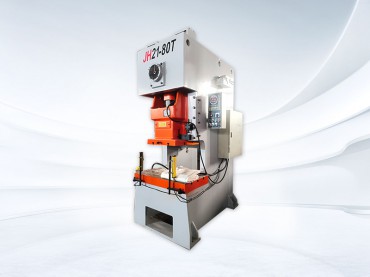

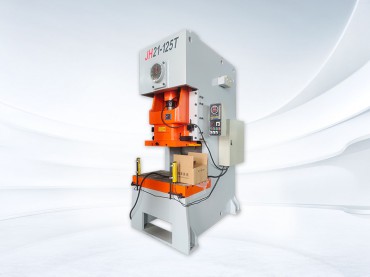






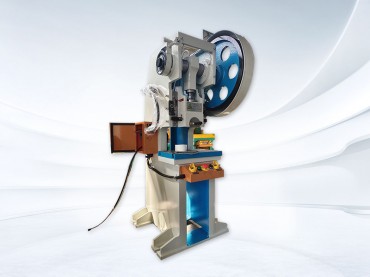
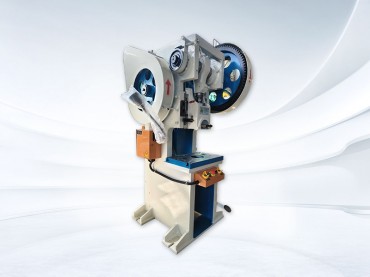


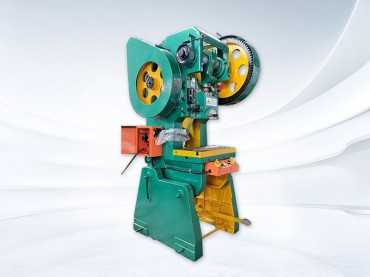

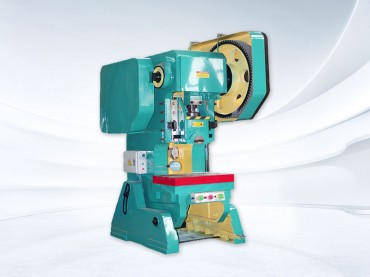



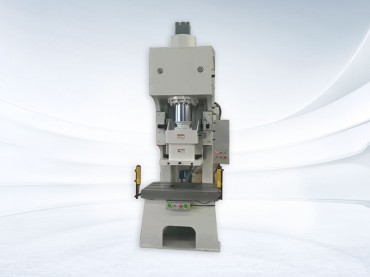

1,Machine model name
Model: J21-160T fixed table mechanical punching machine
Image(For reference only):

2, Main parameters

3, Structure and performance
The main components of the punch press are mostly made of high-strength castings, and the whole machine is composed of a body, large gears, pulleys, crankshafts, connecting rods, transmission shafts, clutches, sliders, and other parts. The drive shaft transmits the power of the electric motor to the pulley, and drives the crankshaft to rotate through the clutch of the clutch, thereby causing the slider to move up and down. When it reaches the bottom dead center, it generates the maximum pressure to achieve the stamping of the workpiece. The slider guide rail has been finely ground by a grinder to increase stamping accuracy and improve its service life. The punch press is equipped with a well-known set of electrical appliances and centralized lubrication by an oil pump.
Punching machine is an efficient and low consumption processing equipment that can achieve stamping, forming, cutting, stretching and other processes for metal and non-metal materials. With its unique advantages, it is widely used in mechanical manufacturing industries such as automobiles, aviation, hardware, electrical appliances, and light industry, and occupies an important position.
The main components of this press include: 1. Body 2, transmission 3, clutch 4, slider 5, brake 6, and control mechanism. The structure and adjustment instructions of each component are as follows:
3-1. Body
The body is an open double column C-shaped integral cast iron component, adopting an integrated structure to increase stability. There is a rectangular circular feeding hole in the middle of the machine body workbench for dropping out workpieces or waste materials. The machine body workbench is equipped with a workbench pad that is fastened to the workbench with bolts. The pad pad has T-shaped grooves for installing molds. The left and right guide rails are fastened to the body with screws, and the slider uses the V-shaped groove of the guide rail to ensure the accuracy of its vertical movement. The crankshaft is closed horizontally, and the shaft sleeve is fixed to the body with bolts. The crankshaft rotates and moves inside the shaft sleeve. There are two holes at the rear of the fuselage to support the left and right bearing seats of the bearings. There is a control mechanism installed on the right side of the fuselage. Driven by an electromagnet.
3-2. Transmission device
The transmission system is powered by an electric motor installed above and behind the fuselage. The starting of the electric motor is achieved by driving the flywheel through the transmission shaft through a small pulley triangle belt under idle operation, and then driving the large gear through the small gear. The crankshaft is rotated by the clutch mechanism that connects the large gear with the crankshaft, and the slider moves up and down back and forth with the eccentricity of the crankshaft. The motor is fixed on the motor base plate, and is supported on the left and right arch backs of the machine body with the help of connecting bracket joint bolts. The tightness of the V-belt can be adjusted by rotating the nuts on the joint bolts.
3-3. Clutch
The clutch is placed on the right end of the crankshaft. The rotary key of the clutch is the rolling key. When in the separation position, the operator's contact pressed against the key handle of the rotary key, and the working key was hidden in the rotary key socket of the clutch disc, causing the large gear to idle. When combined, the manipulator rotates to one side under the pull of the foot switch, and the key handle no longer presses against it. Therefore, the rotary key enters the groove of the coupling ring through the action of the tension spring, driving the crankshaft to rotate and achieve stamping. The opening and closing of the work key realizes the disengagement and cooperation of the clutch, thereby controlling the operation of the slider.
3-4. Sliding block
The slider is located between the body rails and moves up and down in a straight line in the V-shaped groove of the rail through the rotational motion of the crankshaft. The connection between the slider and the crankshaft is achieved by mounting the connecting rod on the shaft handle. The connecting rod is threaded with the connecting rod screw, and the other end of the connecting rod screw is a ball head type. The ball head is pressed onto the slider through a ball shaped cover. There is a safety block under the ball pad, which collapses to ensure equipment safety when the press is overloaded. The distance between the bottom plane of the slider and the worktable plane can be adjusted by rotating the connecting rod screw to meet the requirements of the mold height. The pressure iron is used to clamp the mold handle, and there is a mold handle hole with a diameter of 80 millimeters between the pressure iron and the slider. The pressure mold is fastened to the slider with double headed bolts, and then the mold handle is tightened with square head cylindrical screws to prevent the mold from rotating and moving downward. The slider is equipped with a return plate. When the slider moves upward, the return plate touches the return head installed on the machine body, causing the stamped products or waste to fall off from the mold.
3-5. Brake system
The brake wheel is circular and fixed to the left end of the crankshaft with a key, which belongs to continuous braking: the brake belt wrapped around the brake wheel is made of soft steel skin, and the inner surface is riveted with copper wire and asbestos brake belt. One end of the brake band is riveted with a steel plate, which is mounted on the body with a pin shaft, and the other end is riveted with a pull rod. The screw passes through the spring sleeve and is connected together with a nut. A spring is installed on it to adjust the spring tension and generate the required braking torque on the brake, making the slider move smoothly up and down.
When the braking force is working normally, the inertia moment generated when the clutch disengages the slider and the crankshaft stops causes the crankshaft to stop within ± 5 degrees of the bottom dead center.
3-6. Manipulating mechanism
This machine tool adopts an electromagnetic control mechanism, which uses an electromagnet to control the up and down movement of the manipulator rod, achieving the engagement and disengagement of the clutch. Thus achieving single or continuous stamping of the slider. The electromagnet is placed on the right side of the machine tool and connected to the lever of the manipulator with a clamp block. When the foot switch is pressed or the two hand start button is pressed, the clutch engages and the slider works. The control mechanism of this machine tool is divided into two types: foot switch and two hand start button. When the conversion switch is switched to single use, pressing the foot switch or the two hand start button will stop the slider stroke once. If you need to press again, you need to press the switch again. Switch to continuous gear and press the switch to achieve continuous operation.
4. Machine tool electrical system
The overview of the electrical control system of this machine is as follows:
Main power supply: 380V, 50Hz, three-phase, control power supply: 220V. The main circuit and motor are both equipped with automatic switches for short-circuit protection and overload protection. The control circuit adopts fuses for short-circuit protection. The main components of the machine are reliably grounded.
5,Working environment and usage conditions
This machine is suitable for any material preparation workshop, with the following conditions:
1. Environmental temperature: -20~+40 ℃
2. Relative humidity: ≤ 80% (+25 ℃)
This machine does not emit any "three wastes" and its noise limit meets the requirements of JB9969-1999..
6, Lubrication system
The lubrication system adopts a manual oil pump centralized oil supply method, and the oil circuit is distributed to each oil supply point through a distributor. The distributor is equipped with a regulating valve, which can adjust the oil supply situation of each oil supply point to ensure sufficient oil supply at each oil supply point. This system has a compact structure, reduces pipeline connections, and improves the lubrication and ease of maintenance of the system.
7,Main configurations


If you need punching machines or are interested in punching machines, please provide the tonnage of punching machines or sheet materials, sheet thickness, sheet width, punching diameter, and we will recommend suitable punching machines for you.
 Address:Room 1202, Detaitang Building, No. 118 Huaguang Road, Zhangdian District, Zibo, Shandong
Address:Room 1202, Detaitang Building, No. 118 Huaguang Road, Zhangdian District, Zibo, Shandong WhatsApp:+8615653328535
WhatsApp:+8615653328535 Wechat: +8615965331535
Wechat: +8615965331535  E-mail:zs@sdsmachinery.com
E-mail:zs@sdsmachinery.com